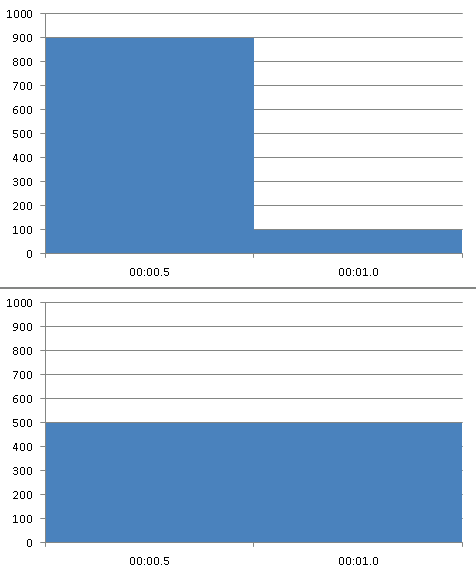Per Second Measurements Don’t Cut It
Kyle Brandt
Transfer rates and the number of packets you send are measured in units of a certain quantity of data per units of time. The unit of time that everyone is used to is the second. The standard quantity of data that is used in the networking field is bits and the standard time unit is seconds. So for example, the standard network interface these days is 1 Gigabit per second. So the quantity of data is a Gigabit, and the unit of time is a second. We call this the transfer rate. The key thing to remember is that this is a fixed ratio of data over time. Because of this, you can divide the ratio by any number you want to (Ignoring the complexities of the discrete properties of Ethernet frequencies, system clocking, etc). So, 500 Mbit over a half second is the same fixed ratio as 1 Gigabit per second.
The thing is though, in computing, a second is a really, really, really long time. This is important, because when we choose what unit of time to express this in, what we are doing is graph smoothing (It is sort of, although not really, like taking an average).
For example, we could transfer 900 Mbit in half of a second and another 100 Mbit for the other half of that second. How much data was transferred during that second? The answer is 1 Gbit. If we transfer 500 Mbit per half second and another 500 Mbit per the other half second — this is also 1 Gbit per second:. This effect is illustrated in these Megabits per half second graphs:
These two are clearly not the same thing, but when you express them as the amount of data transfered over a second they are. This is important because a 1 Gbit per second interface is also a 500 Mbit per half second interface — and a 500 Mbit per half second interface can’t transfer 900 Mbits per half second (I am ignoring any buffering effects, but in practice we have found this to be essentially true).
This effect is made even worse by most monitoring tools because most take samples every 5 minutes. So what you are really seeing is the transfer rate per 5 minutes converted to a per second rate. This sort of thing is why people say data can lie.
Why Should you Care?
We discovered that we were discarding packets pretty frequently on 1 Gbit/s interfaces at rates of only 10-30 MBit/s which hurts our performance. This is because that 10-30 MBit/s rate is really the number of bits transfered per 5 minutes converted to a one second rate. When we dug in closer with Wireshark and used one millisecond IO graphing, we saw we would frequently burst the 1 Mbit per millisecond rate of the so called 1 Gbit/s interfaces.
We have bonded these interfaces using Intel Load Balancing (ALB/RLB) and for the most part our discards have gone away. We did this on all but one of our web servers for a while and found that the one that didn’t have the bonded interface had discards climbing while the others did not.
A second is a long time — be wary of trusting it too much to measure things.
Have You Tried Turning it Off and On Again?
Kyle Brandt
When you have an infrastructure problem, rebooting the machine(s) is something you should do as a last resort. The reason is that you likely will never learn what the problem was, and it is probably going to come up again. I generally deplore this sort of troubleshooting and wrote about that opinion in my previous “Push the Green Button Twice” post. That being said, this is what we resorted to this past Friday for our entire switching infrastructure. This brought us offline for several minutes.
It all started on a Rainy Evening this Past Wednesday…
On Wednesday evening of this past week we started to see network timeouts in our application logs. Digging into this further and checking more logs this seemed to be widespread. On our Linux routers which run carp on the LAN side we saw some flapping going on. On our load balancers, we saw messages about late heartbeat messages. We use failover Intel teaming on our web server NICs and saw errors about missing probes. The problem was wide spread enough that it seemed to be the switching infrastructure, however there were no significant errors in the switch logs. We did see some ASIC and interface drops, but the incrementing of these did not seem to always coincide with major network blips in our infrastructure.
We then tried to localize the problem. We took network captures, and lots of them. Some from SPAN ports covering all of our traffic. Some from examples between select servers from the viewpoint of both servers as well as the viewpoint of the switch ports they were attached to. In addition to this we did iperf tests and ping tests between all sorts of different points in our network. We did broadcast analysis, tcp analysis, latency analysis, and IO graphing. Several of us worked pretty much around the clock for three days trying to figure this out. Although from the outside we were pretty much up, users were seeing timeouts. We even brought Cisco support into the mix and went through 3 support techs.
After three days of this, we honestly didn’t know a whole lot more than we did when we started — we were losing packets. We thought a lot about what we changed when this all started to happen and couldn’t think of anything. About two weeks ago we changed our switch configuration to a stacked setup using flexstack. Although a major change, it was two weeks ago. When we start to go down this road we are just starting to guess. Unless you actually see evidence that points to something, you really could say it is just about anything. The switch stacking is more related to what is going on, but there have been more recent changes — like the fact that it was raining — perhaps it was the rain?
When the jokes about what might be causing the problem become just as frequent as reasonable theories, that is probably the time to just try turning it off and on again — and that is what we did. It seems to have fixed the problem, but the weekend is our low traffic point and it could just seem fine because of that. This could also be some sort time based bug or something that is only triggered under a certain conditions.
Our Best Current Theory
Although traffic on most of our interfaces is quite low, lower than 100Mbit/s on Gigabit ports, it occured to me that maybe we were saturating more small scale units of time. I posted a question about this on Server Fault. The basic idea is that 1GBit per second is also 1Mbit per millisecond, and we are spiking the one millisecond limt frequently. If that is a realistic limit, our captures confirm that we do hit a lot. Perhaps enough of these spikes punishes the switches enough to trigger an unknown IOS bug?
This is still just a guess, but it is at least a plausible theory. So the solution we are going implement is a network architecture change I had planned on if we ever approached the 1 GBit/s bottleneck. We are going to set up a dedicated VLAN between our web servers and database servers that uses dedicated NIC ports. This dedicated path also won’t traverse the router making sure there isn’t a gateway bottleneck. The database traffic from the web tier will have its own dedicated interfaces that don’t have to share the path with our redis caching traffic and http traffic. Lastly we will bond these with an active-active method that will give us more throughput.
We don’t know if this will help prevent this problem or not, but we all think it is a better architecture so either way it is an optimization worth doing.
A Lesson in Troubleshooting Complex Problems — Document As You Go
The biggest mistake we made in this process so far in my opinion was not documenting our troubleshooting while we are doing it. By the time we got to Friday, we had a lot of data points. There were enough that we had trouble keeping them all in our head. That made it hard to make sense of them and our thoughts would go in circles at times. Even worse, we questioned if what we remembered and if our tests were even accurate.
Going forward I think we should use a collaborative document system like Google Docs to document our troubleshooting and any ideas we have as we go. Each test we do should include:
- When the test was run in UTC time and who ran it
- Screenshot(s) of the test. This is very important so people can verify the results, and repeat the test.
- Attachments and/or links to where the file is of logs and things like capture. Captures should include screen shots of graphs and analysis as well.
- Whatever conclusions you think can draw at the time from the testing as it relates to the problem.
With this on day two we can look at what we have done so far and what the sum of it all what logically might mean. Also, when people are taking breaks or are away, when they come back they can get caught up on what is happening. In the long run it will save time and make the troubleshooting more effective. We can still use an open phone line to communicate, but this would record the most important tests and ideas.
I really hope we stay calm enough and have the discipline to do this text time we deal with a major problem.
With all my talk of doing things in a scalable way comes a requirement, and that is that we actually accomplish this stuff in practice at Stack Exchange. We have been making a lot of progress in this area. George has been refining and expanding our deployment process. He improved our Windows deployment to include most of the software we use and has made it so kickstart for CentOS/Linux installs are integrated into our deployment as well.
Scaling your ability to manage your environment in my mind means doing more with less. I find I really only have to ask myself one question to quickly gauge if we are doing it right or not.
Do I have to repeat steps to do this task on multiple servers?
I like this question because it is more specific than “Is it automated?” while still implying automation. It is akin to the DRY rule in programming: “Don’t repeat yourself.”
When it comes to our environment, here is where we are at. For this I will ignore some details — for instance, we log into servers to kick off a PXE install and then just let it go — I consider that a Yes to “No repetition required” since it is only one or two steps and we don’t really deploy more than a server at a time. We don’t want to automate to the point over engineering beyond the projected size of our environment.
| Task | No repetition required | Solution or Proposed Solution |
|---|---|---|
| Windows OS Deployment | Yes | Microsoft Deployment Toolkit with LiteTouch |
| Linux OS Deployment | Yes | WDS which redirects to PXELinux and Kickstart |
| Windows OS Updates | Yes | Windows Update Services |
| Linux OS Updates | No | Kick them off with Cron or Puppet? Spacewalk? |
| Windows Firmware Updates | No | Exploring what Dell has to offer that might tie into System Center |
| Linux Firmware Updates | No | Run binaries with Puppet? (kind of scary) |
| Windows Software Deployment and Updates | No1 | Microsoft System Center |
| Linux Software Deployment Updates | Yes | Puppet† |
| Windows Configuration Management | No (with the exception of IIS and web related configs) | Microsoft System Center |
| Linux Configuration Management | Yes | Puppet† |
| Automated Deployment of Monitoring and Backup Configuration | No | No ideas at this point |
1We do have some software that can be deployed via GPO, and LiteTouch deploys a lot of stack on the web servers during deployment. But future software updates and software that doesn’t lend itself to GPO is manual.
† I am currently in the middle of rolling out puppet so it is partially deployed on some of our Linux servers
The big picture of all of this is deployment as phase 1 and maintenance as phase 2 for both Windows and Linux. Also, ideally these phases connect to each other seamlessly.
One of our main goals is to change all of the above “No” to “Yes” over the next few months and then refine each step. For the most point we have deployment taken care of for both Windows and Linux. As far as maintenance goes, I believe as I progress in rolling out Puppet that will solve the vast majority of our Linux needs. How we will manage our firmware is still an unknown. As far as Window maintenance goes we are going to start exploring System Center soon and hope that it can meet our needs.
What I really think all of this will buy us is consistency, recoverability, and most importantly — time. By having all of this centrally managed it will make our servers more consitent with each other — and make them effectively drones. By having these processes automated we will be able to recover fast and replace servers easily. Lastly, and most importantly it buys time. By making our management faster and more agile, George and I can focus on rapidly deploying improvements to our environment instead of just maintaining it. By having less friction to deploying changes to our infrastructure I believe more possibilities for improvement will start emerge.
Press the Green Button Twice
Kyle Brandt
Most people in the system administration field I have talked to agree that the professionalization of system administration is happening faster. System administrators have always been paid, that isn’t what I mean by professionalization. What I do mean is that more leaders are emerging, participating in local groups, blogging, and participating on sites like Server Fault. The end results is that the standard of the profession is going up. That doesn’t mean that there hasn’t always been great people — but I believe the average expected expertise is increasing in the field.
One of the main ways I see this happening is in what people expect from answers on Server Fault. Lets take a hypothetical question:
“On my AFSRQ 2000, the system crashes every week or so. I managed to capture my logs before the crash: …. However, I am not sure what these lines mean?”
An acceptable answer to many system administrators would have been something like following as long as the AFSRQ 2000 stops crashing:
“Have you tried pressing the green button twice? Last time I did that it fixed my issues.”
The problem with this sort of answer is that it spreads ignorance. If there is no understanding of what the green button does, no wisdom can be gained from an answer like this. If the answer to how the fix works and why it works is missing, then this knowledge can not be applied to future related situations.  Eventually, the AFSRQ 2000 will be upgraded to the AFSRQ 2008, and then button might not even exist, or, even worse, it might be a red button. Even if it solves this specific problem it doesn’t really help the profession advance. Also what happens is people attempt to press the green button to solve every problem — even when it wouldn’t help at all.
Eventually, the AFSRQ 2000 will be upgraded to the AFSRQ 2008, and then button might not even exist, or, even worse, it might be a red button. Even if it solves this specific problem it doesn’t really help the profession advance. Also what happens is people attempt to press the green button to solve every problem — even when it wouldn’t help at all.
The better way to answer this is to try to understand why pressing the green button stops the system from crashing. Answer what causes the crash in the first place. The goal should be that answers should be expressed in the context of computing fundamentals and backed up by real data. By fundamentals I mean things like how operating systems work, system calls, memory management, network traces, hardware, etc. The reason is that when problems and answers are expressed in terms of fundamental building blocks patterns can emerge. Recognizing and understanding these patterns is what experience is system administration is really about. When answers are backed with real data (it helps when vendors empower you with tools to get the data), then this also gives context and proof, and other system administrators can verify the information. These are the sort of answers that raise the level of our field, pressing the green button twice does not.


